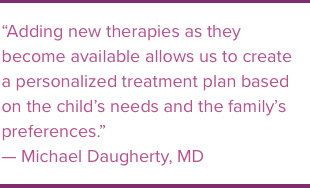Families Dealing with Voiding Dysfunction Can Find All the Therapies They Need in One Place

The Division of Pediatric Urology at Cincinnati Children’s can now offer patients with voiding dysfunction the full array of interventions, including medication, behavioral modification, biofeedback, pelvic floor therapy, percutaneous tibial nerve stimulation (PTNS) and sacral nerve stimulation (SNS).
“Our program has evolved as families continue to seek alternative treatments beyond medication to treat the dyscoordination associated with voiding that can lead to most urinary symptoms,” says pediatric urologist Michael Daugherty, MD. “Adding new therapies as they become available allows us to create a personalized treatment plan based on the child’s needs and the family’s preferences.”
The urology team provides all of the therapies except pelvic floor therapy, which is done by physical therapists at Cincinnati Children’s. Biofeedback and pelvic floor therapy both teach children about pelvic floor muscle control and how it should occur in the voiding process. In the past year, urology nurses and physical therapists have worked collaboratively to create care pathways to help clinicians decide with families which therapy offers the most benefit.

“Biofeedback can be very effective, but pelvic floor therapy is often a better option for children who have voiding dysfunction plus more complex concerns, such as significant constipation, connective tissue disorders and sensory issues,” Daugherty says. “The physical therapists can do a comprehensive, head-to-toe assessment and address any urinary and bowel issues not only with pelvic floor therapy but with other strategies like core strengthening and body posture training.”
The collaboration with physical therapy (PT) has led to a standardized care management approach that Daugherty hopes will improve adherence and outcomes.
“Deciding which therapy may work best isn’t as clear-cut as we’d like it to be, but at least now we have care pathways to guide our recommendations,” he says. “The referrals can flow either way between our departments. If biofeedback doesn’t work despite patient commitment, we’ll reach out to PT early in the process to discuss a more aggressive approach. If a patient improves their core strength with physical therapy, PT may recommend that they switch to biofeedback to improve pelvic floor muscle strength.”
Patients with voiding dysfunction that is refractory to noninvasive therapies may be offered PTNS or SNS. Both stimulate the posterior tibial nerve and optimize the neural communication between the bladder and brain.
- SNS involves implanting a small neurostimulator in the upper buttock area. It delivers gentle electrical impulses through a lead placed in the third sacral foramen of the patient’s spine.
- PTNS involves placing a thin electrode needle on the nerve at the back of the foot and connected to a hand-held stimulator that controls the impulses passing into the nerve. Patients typically require eight to 12 visits to achieve optimal results.
“Not very many pediatric institutions offer all of these therapies for children with voiding dysfunction, but we want to provide as many options as possible,” Daugherty says. “We work closely with families to help them understand what each therapy involves and how it could benefit their child.”

